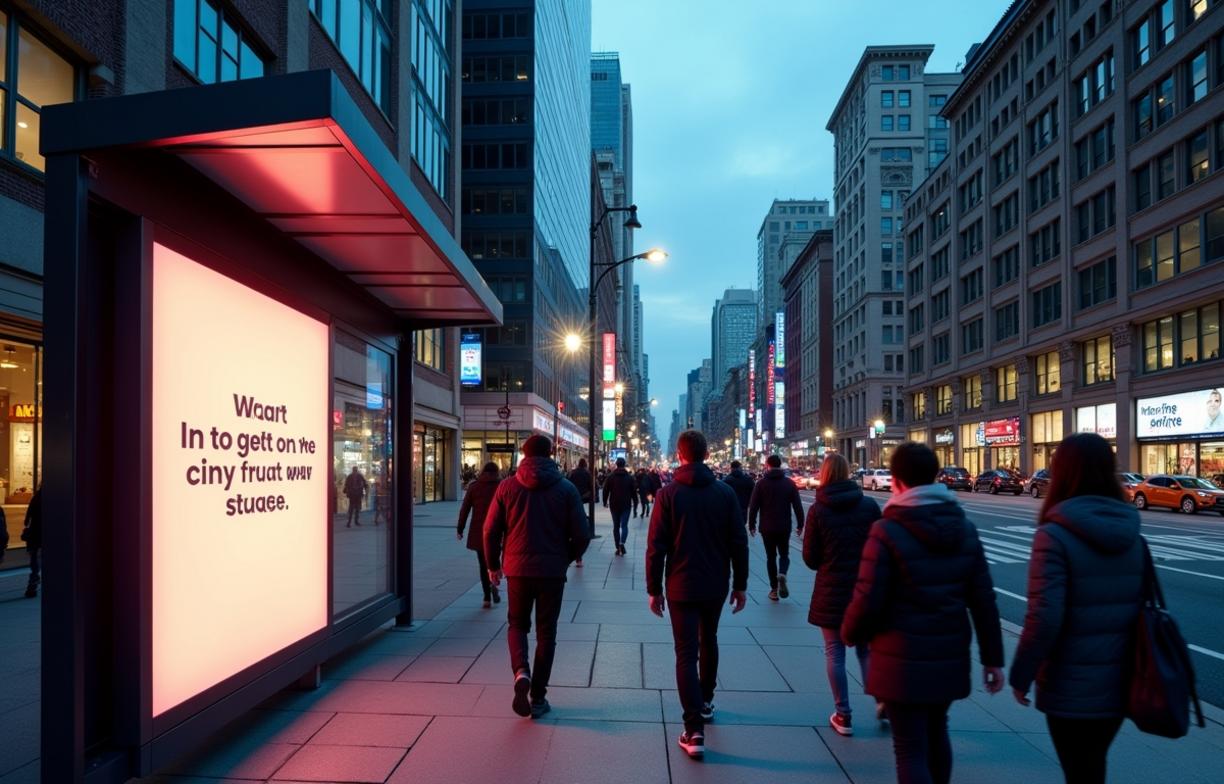Brands have long used various methods to convey ideas, including outdoor advertising. Shining from billboards, transit signs, and vibrant displays in commercial centers, it stands out amid digital clutter. People pass by these messages daily, whether they’re heading to work or enjoying a weekend stroll. When paired with modern channels, those real-world impressions can do more than just catch an eye; they can harmonize perfectly with digital outreach. Marketers today are exploring fresh techniques to unify outdoor placements with data-driven campaigns, all in pursuit of a well-rounded brand experience.
Omnichannel marketing thrives by meeting consumers where they already spend time online, in store, or in the physical world. Outdoor placements hold a unique place in that mix. Generating a sense of scale and familiarity, they offer lasting brand reinforcement. In an era where people swipe through content in seconds, these larger-than-life visuals have the power to stick. By pairing them with social media, mobile apps, and your website, you can weave a unified narrative that runs across every medium. That way, your message feels consistent and genuine, whether the viewer sees it in a subway station or on their smartphone.
Contents
- 1 Why Outdoor Ads Remain Essential
- 2 Strengthening Cross-Channel Synergy
- 3 Aligning With Digital Touchpoints
- 4 Building a Multi-Channel Marketing Strategy
- 5 Measuring Impact and Adapting
- 6 Cultivating a Consistent Brand Message
- 7 Elevating Brand Recall Through Repetition
- 8 Optimizing the Future of Omnichannel
Why Outdoor Ads Remain Essential
Outdoor placements can do things digital campaigns cannot. With bold visuals and strategic placement, they grab attention in everyday life. Shoppers on the go can spot them in high-traffic intersections, building brand recall even without a click or a share. The repetition of a striking display fosters brand loyalty, especially when the same visuals or themes reappear across other channels.
When a clear brand identity anchors your outdoor message, it resonates beyond location-based campaigns. A consistent color palette or tagline makes it more likely people will remember your name once they check social media or browse online. This synergy sparks familiarity, carving a spot in the consumer’s mind. In turn, when they finally see your digital ad in their newsfeed, it feels like an old friend rather than a pushy invite from a stranger.
Tapping into Emotional Resonance
Large-scale displays make it easier to engage emotionally with passersby. Whether you’re appealing to humor, aspiration, or compassion, the sheer size of outdoor imagery amplifies the sentiment behind it. People sense a certain authenticity when they see a real-world poster or billboard. That emotional link can become a powerful ally in your broader marketing efforts.
Strengthening Cross-Channel Synergy
To get the most from your brand’s investment, your campaign must flow seamlessly from sidewalks and highways to smartphones and social feeds. A cross-channel approach ensures you never miss prime opportunities to nurture consumer trust. By uniting channels in this way, every part of the marketing puzzle supports and reinforces the others, rather than existing in isolated silos.
Some brands slap the same design or slogan across various platforms and hope for the best. But synergy grows stronger when you tailor each message for the medium while preserving the central theme. For instance, a roadside billboard might use a short phrase and striking image that piques curiosity. On social channels, you can expand on that message with compelling stories or interactive polls. The result is a unified experience that delights the consumer instead of bombarding them with repetitive slogans.
Coordinating Timing and Context
A pivotal part of cross-channel marketing is to time messages so they align with relevant events or seasonal trends. Suppose you launch a new product line in spring. A vibrant outdoor ad could set a cheerful tone for your social media posts. When people see your billboard on their commute, then later spot a similar design on their news feed, it sparks recognition. This thoughtful synchronization elevates your brand’s credibility and drives positive sentiment.
Aligning With Digital Touchpoints
Amplifying outdoor efforts with digital touchpoints can supercharge brand engagement. One effective tactic involves using outdoor to spur curiosity, so people search for more information on your website or social channels. QR codes printed on banners or bus stop ads now align with smartphone-savvy consumers. They can scan the code and land on landing pages featuring discounts or exclusive content.
Forward-thinking marketers also leverage geotargeting to measure the offline success of an outdoor placement. By analyzing digital foot traffic in a specific location after an ad goes live, you can identify patterns of user behavior. This data helps refine messaging for future campaigns, ensuring each display resonates more profoundly with the audience.
Matching Creative Elements Across Channels
Matching your colors, fonts, and brand voice across social media, videos, website content, and offline placements is crucial. People expect a smooth experience when they interact with your brand. If a billboard announces a new product but your website lists outdated information, trust erodes. Consistency ensures that when a shopper sees your bus shelter display, then lands on your product page, they perceive the same design elements and messaging.
Subtle cues, like a tag line or signature color, tie your outdoor and digital materials together. Even minute details like a recurring symbol in your ads help unify your brand identity. This cohesive thread can guide people from outdoor impressions all the way to choosing your product or service.
Building a Multi-Channel Marketing Strategy
An effective multi-channel strategy extends beyond simply placing copy and images on each platform. It involves throwing the spotlight on consumer needs at different points in the buyer journey. Your brand should remain consistent, yet still respond to the varied expectations people bring to each channel.
Outdoor displays might spark broad awareness for your brand or a specific product line. Social media platforms, on the other hand, allow for direct interaction, questions, and deeper connections. Email campaigns let you nurture leads in a more personal way. All these moving parts can be steered by a comprehensive marketing plan that aligns each channel’s timing and message.
Handling Feedback from Multiple Sources
When people see your outdoor ads, they might later comment about them on social channels. Monitoring these interactions reveals how your audience actually feels about the display. You may discover that a particular tagline resonates better with certain demographics. Adjusting your plan based on that feedback is easier when your approach is flexible and agile.
Measuring Impact and Adapting
Data is vital to gauge the true value of an omnichannel marketing campaign. By tracking key performance indicators, you can fine-tune areas where certain channels aren’t pulling their weight. Outdoor advertising is sometimes overlooked in this process because it’s not as straightforward to track as clicks. Yet there are creative ways to measure its success and integrate those findings into your overall strategy.
For example, you could align a specific outdoor campaign with a unique redemption code or dedicated landing page. This helps quantify how many consumers act on the messaging they see in real-world spaces. Pairing that information with online analytics offers a more complete picture. That means you can see exactly how offline engagement influences digital behavior and vice versa.
Real-Time Adjustments
Marketing technology advances allow you to switch out creative messages on certain digital billboards. If you notice a spike in interest around a recent product unveiling, you can swap your static signage for a design highlighting that item. Real-time adaptability puts you in direct control of how your brand shows up in high-traffic spots. Over time, you can roll out these responsive displays in multiple locations, elevating the consumer experience.
Cultivating a Consistent Brand Message
A key part of any omnichannel approach is speaking with a unified brand voice. That means your audience should recognize your unique tone and style in every ad or social post. Outdoor is often the first point of contact for many potential customers. Ensuring that the brand messaging translates seamlessly into digital channels helps maintain credibility.
Few things confuse consumers more than a brand that lacks coherence. If your outdoor designs look sharp but your social media updates feel disconnected, people might not feel confident in your product. Crafting a steady presence reassures individuals that you’re consistent, reliable, and worth their trust.
Human-Centered Storytelling
Storytelling thrives when it taps into the shared experiences of your audience. Outdoor stories can be short yet striking, guiding people to learn more online. When you craft your narrative with empathy, folks see that your brand values align with theirs. This emotional hook can motivate them to explore your offerings in greater depth.
Elevating Brand Recall Through Repetition
Repetition, when done right, leaves a lasting imprint on a viewer’s mind. Strategic outdoor placements bring your imagery and tag line to life in tangible spaces. Reuniting that same theme on social feeds, emails, and other channels makes the message sink in deeper. It can significantly boost recall and spark conversations.
Design your outdoor visuals to complement other formats without overwhelming the messaging. If your main campaign visuals feature bold typography, maintain that feel digitally. Think of it like a consistent refrain in a song, delivering steady momentum that carries your audience from one touchpoint to the next. Each encounter amplifies recognition, creating stronger connections.
Non-Intrusive Engagement
Another advantage of outdoor is its non-intrusive nature. People may look up at a billboard without feeling pressured to engage. Later, when they see your ads online, they recall the brand from the billboard, forging a sense of familiarity. This blend of subtle exposure and direct interaction can create a customer journey that feels natural and unforced.
Optimizing the Future of Omnichannel
As marketing evolves, the ability to merge traditional formats with modern technologies will become even more important. Outdoor advertising remains a cornerstone of brand visibility, but pairing it with data-driven insights transforms your efforts from guesswork to precise execution. Real-world impressions offer authenticity, while digital tools deliver accountability and adaptability.
Your creative approach should constantly adjust to new trends in consumer behavior. Collect data on each channel, test fresh angles, and refine your audience targeting. The objective is to introduce customers to your world in a way that feels organic and valuable. When everything fits together, the brand journey becomes something people look forward to rather than simply endure.
Embracing Continuous Innovation
Innovations ranging from augmented reality billboards to location-based offers can bring fresh life to your outdoor investment. Interactive experiences around city centers or events blend physical presence with digital connection. By staying open to technology’s potential and focusing on consumer expectations, you can keep pace with how audiences move through changing environments.
In the end, the cross-pollination of outdoor advertising with digital channels is all about reaching people in every corner of their lives. Then, instead of fragmented messaging, a seamless and memorable story unfolds. You stand out not just through sheer presence but by being relevant, reliable, and worth engaging with time and again. The more your brand embraces these creative possibilities, the stronger its position becomes in a crowded marketplace.



